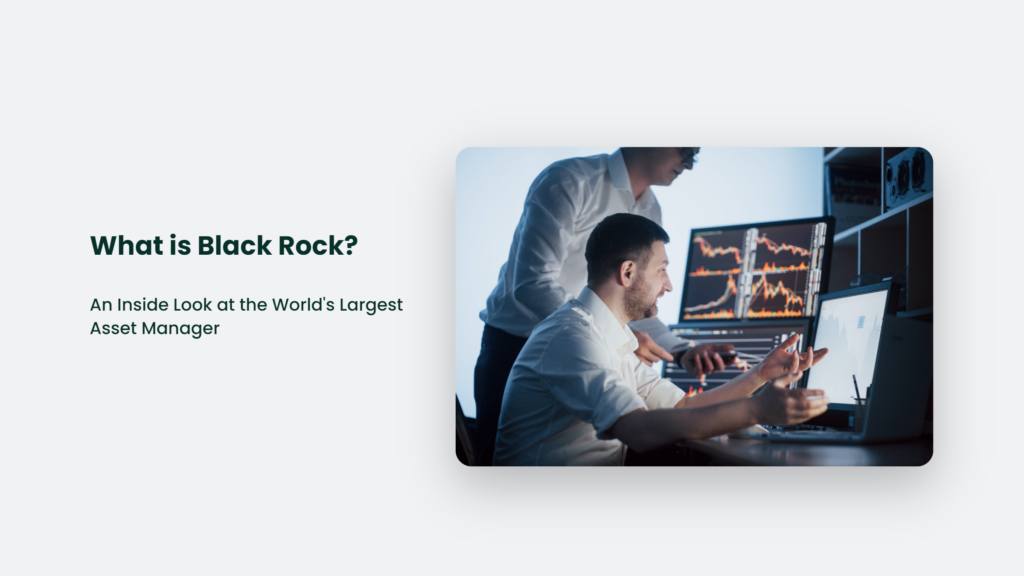BlackRock. The name elicits images of a dark, foreboding monolith cast against the financial skyline. This juggernaut stands tall in the asset management world, casting its long shadow over the investments of millions. But what is Black Rock? What is behind the curtain of this financial wizard?

What is Black Rock? The Origins of an Investment Behemoth
BlackRock’s origins stem from a bold vision to create an investor-centered firm that could weather any storm. In 1988, global investors Blackstone, First Boston, and Merrill Lynch backed the launch of BlackRock as an independent investment manager. The goal? To provide unmatched insight, expertise, and options to clients.
This maverick firm has since lived up to those lofty ambitions. BlackRock now reigns as the world’s largest asset manager; as of the second quarter of 2023, BlackRock had total assets under management (AUM) of around 9.4 trillion U.S. dollars. To put this into perspective, if BlackRock were a country, it would have the third-highest GDP globally.
But how did this financial giant grow so large? BlackRock ascended by:
- Offering comprehensive, customizable investment solutions to clients
- Expanding into high-growth markets like exchange-traded funds (ETFs)
- Acquiring competitors, including Barclays Global Investors and Merrill Lynch Investment Managers
Yet, BlackRock’s meteoric rise is more than just masterful market maneuvering. It stems from a fundamental belief in the power of investment to transform lives.
More Than Just Money: BlackRock’s Vision for Investing
“We focus on sustainability not because we’re environmentalists, but because we are capitalists and fiduciaries to our clients.” – Larry Fink, CEO, BlackRock.
Larry Fink and BlackRock believe investing holds unique potential to effect positive change. How so? Capital steers the global economy, funding innovation and opportunity. BlackRock aims to mobilize that capital for the betterment of clients, communities, and society overall.
It manifests through initiatives like:
- Pushing companies to prioritize sustainable long-term growth over short-term profits
- Creating affordable, socially responsible funds for retail investors
- Advocating for increased financial inclusion worldwide
But how exactly does BlackRock deploy all this vision and virtue on behalf of investors? Let’s analyze the firm’s structure and offerings.
Demystifying the BlackRock Platform: Key Business Lines
BlackRock champions a unified approach it calls “One BlackRock.” It means integrating various investment strategies, risk management, technology, and client service across the firm. Clients then can tap the full breadth of BlackRock’s capabilities.
Here is an overview of BlackRock’s main business pillars:
Active Investments
- Human portfolio managers select securities to beat the market
- Flagship active strategies include equities, fixed income, multi-asset, alternatives and liquidity
- Accounts for 27% of assets under management (AUM)
Passive Investments
- Index-tracking funds like ETFs that match market performance
- Includes iconic iShares ETFs brand
- Accounts for 61% of AUM
Alternatives
- Real estate, infrastructure, private equity and hedge funds
- Delivers diversification beyond stocks and bonds
- Accounts for 5% of AUM
This comprehensive menu of active, passive, and alternative strategies gives clients true choices. BlackRock’s sheer size also unlocks advantages like institutional pricing for individuals.
But successfully overseeing over $9 trillion in assets is a challenging feat. There’s enormous complexity behind the scenes – from risk management to technology.
The Brains Behind the Brawn: BlackRock’s Risk and Tech Capabilities
Weathering ever-changing markets for decades requires potent risk management. That’s why BlackRock prioritizes scrutinizing portfolios to identify vulnerabilities. The firm’s renowned Aladdin risk platform monitors $21.6 trillion in assets, including for institutions like banks and governments. It allows BlackRock to provide clients with informed warnings about potential pitfalls.
Technology also plays a crucial role. BlackRock develops robust proprietary software to enable thorough market analysis and smoother operations. BlackRock’s tech expertise even supports entire countries, with Aladdin powering the digital infrastructure for central banks like the Federal Reserve and Bank of Canada.
Additionally, BlackRock leverages A.I., big data and machine learning to enrich decision-making with actionable intelligence. This tech angle helps the firm stay agile despite its size.
Across investments, risk, and technology, BlackRock commands impressive market influence.
By the Numbers: BlackRock’s Staggering Scale
- $9.4 trillion in assets under management
- Over 16,000 employees globally
- Operations in over 30 countries
- 87% of assets under management beat benchmark returns over ten years
- Manages money for over 100 million people
- Consults with over 11,000 financial institutions
These figures reveal BlackRock’s dominance. The powerhouse stands leagues ahead of competitors like Vanguard and State Street Global Advisors. Tech giants like Apple and Microsoft also pale in comparison to AUM.BlackRock’s size affords game-changing consumer benefits, too.
The firm ranks as the top provider of ETFs globally. BlackRock’s iShares funds furnish investors with index investing, diversification, and pricing typically reserved for elite clients. This democratization of finance advances BlackRock’s vision for a more inclusive market.
Yet, with great power comes great responsibility. BlackRock’s influence raises fair questions about stewardship.

BlackRock’s Sense of Purpose: Progress and Criticism
- BlackRock owns at least 5% of shares in over 97% of S&P 500 companies. However, it is typically not the single largest shareholder.
- A 2021 study found BlackRock was among the top 5 shareholders in 40% of Russell 3000 companies. But it was the largest shareholder in only 8.3% of those firms.
- Vanguard and State Street Global Advisors are major shareholders, so BlackRock does not dominate alone.
- BlackRock owns average stakes of 8.1% in S&P 500 firms and 5.2% in Russell 3000 firms. It indicates it does not usually hold a controlling position.
- Critics argue BlackRock has too much influence due to total assets under management, but its stakes in companies are generally minority positions.
As such, BlackRock pushes those firms to adopt sustainable business practices. Fink’s 2022 letter also outlined the firm’s net zero emissions goal to curb climate risk industry-wide. Moves like this demonstrate BlackRock is working to shape capital markets for the better.
However, BlackRock faces allegations of hypocrisy, given its holdings in major oil and gas companies. Critics also blame BlackRock for inflating housing prices via massive real estate investments. Additionally, some view the firm as an anti-competitive monopoly.
In response, BlackRock maintains that it must provide clients wide access to the global markets – not dictate personal choice. As the world’s largest investor, though, BlackRock does have an obligation to advocate for transparency and reform.
On balance, BlackRock makes laudable strides to harness its power positively, even if the firm sometimes falls short. Regardless, BlackRock’s immense impact is undeniable.
Frequently Asked Questions:
What does BlackRock invest in?
BlackRock offers extensive investment products across equities, fixed income, liquidity, real assets, hedge funds and more. The firm’s iShares ETF brand is the world’s top ETF provider.
How big is BlackRock?
As of 2023, BlackRock manages over $9.4 trillion in assets – making it bigger than the annual GDP of most countries. BlackRock is over 3 times larger than its next biggest competitor, Vanguard.
The Bottom Line on BlackRock: An Industry Titan
When the financial system faced a near collapse in 2008, BlackRock stayed resilient. While others crumbled, BlackRock fortified its foundation by upholding client trust and market insight.
This client-first ethos remains central to BlackRock’s identity even 30+ years later. It’s why the firm offers investors robust choice, insights and access today. BlackRock has undoubtedly become a titan – the world’s largest fiduciary with $9.4 trillion in assets. Yet, in a rapidly evolving world, BlackRock remembers its roots by keeping clients at the core. This unique client care and market competence balance cements BlackRock’s status as a global financial force.




